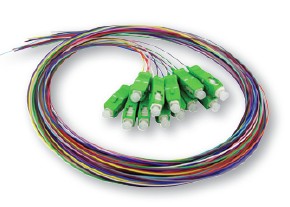In the complex and high-speed world of fiber optic networks, every component plays a critical role in ensuring efficient and reliable data transmission. Among these components, the fiber optic pigtail stands out as a crucial element that often goes unnoticed but is essential for the seamless operation of optical networks.
What is a Fiber Optic Pigtail? A fiber optic pigtail is a short optical fiber cable with an optical connector on one end and exposed fiber on the other. The connector end is designed to be attached to various devices such as switches, transceivers, and patch panels, while the exposed fiber end is used for splicing into other optical fibers. This design allows the pigtail to act as a bridge between different network components, facilitating smooth data transmission.


Fiber Optic Pigtail
Key Features and Benefits:
- Ease of Splicing: Fiber optic pigtails simplify the process of splicing, as the pre-installed connector eliminates the need for field termination. This reduces installation time and minimizes the potential for errors, ensuring a secure and efficient connection.
- High Performance: Pigtails are manufactured to strict standards, ensuring low insertion loss and high return loss. This guarantees that the data signal remains strong and clear, which is vital for high-speed and high-bandwidth applications.
- Versatility: Available in various connector types such as LC, SC, ST, and FC, fiber optic pigtails can be used in a wide range of applications and network setups. They are suitable for use in data centers, telecommunications networks, and enterprise networks.
- Durability: Fiber optic pigtails are designed to withstand harsh environments, including extreme temperatures and physical stress. Their robust construction ensures long-term reliability and consistent performance, reducing the need for frequent maintenance or replacement.
- Cost-Effectiveness: By simplifying the splicing process and reducing installation time, fiber optic pigtails help lower overall network deployment costs. Their durability also means fewer replacements, further contributing to cost savings.
Applications:
- Telecommunications: Pigtails are used to connect fiber optic cables to active devices in telecommunications networks, ensuring reliable voice, video, and data transmission.
- Data Centers: In data centers, pigtails facilitate the connection between servers, storage systems, and networking equipment, supporting high-speed data transfer.
- Fiber to the Home (FTTH): In FTTH deployments, pigtails connect the incoming fiber optic cable to the end-user’s equipment, providing high-speed internet access.
Conclusion: Fiber optic pigtails are a fundamental component of modern fiber optic networks, providing essential connections that ensure efficient and reliable data transmission. Their ease of splicing, high performance, versatility, and durability make them an indispensable tool in the deployment and maintenance of optical networks. As the demand for faster and more reliable connectivity continues to grow, fiber optic pigtails will remain a vital element in the infrastructure of our digital world.

